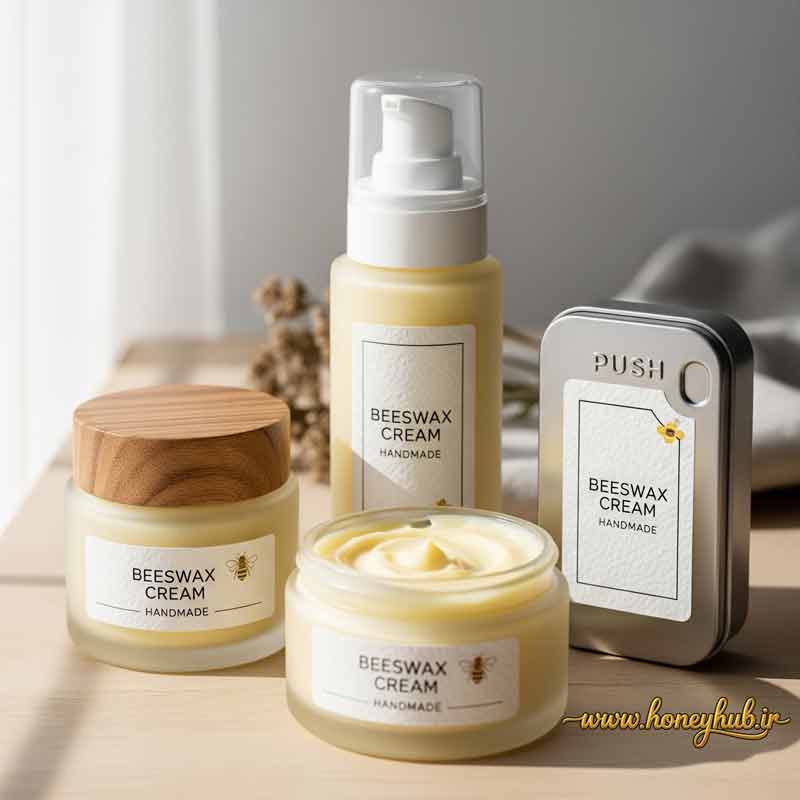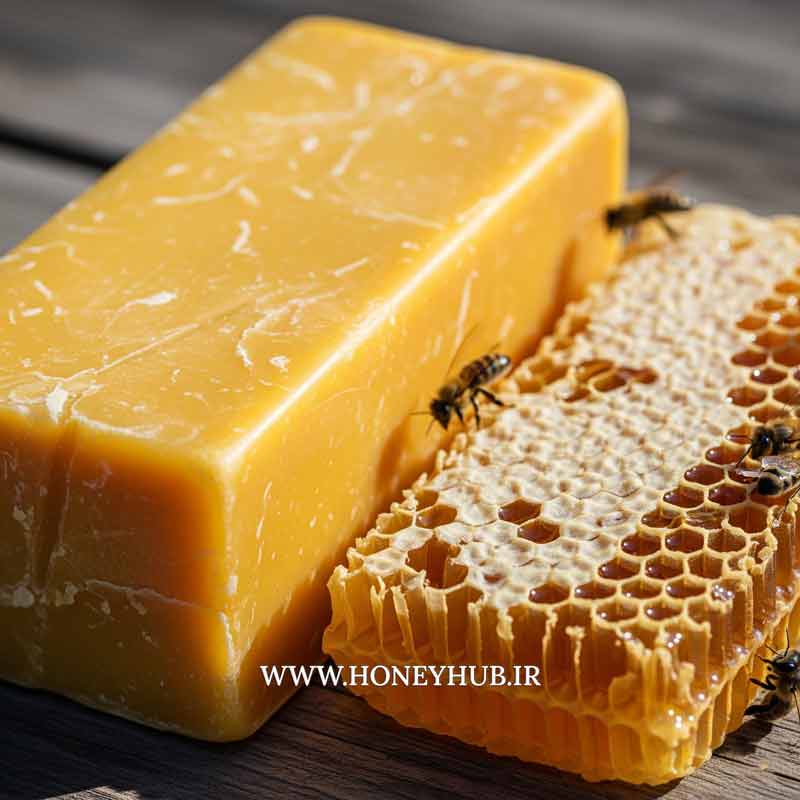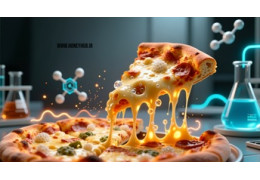Does your mozzarella refuse to stretch or just burn? The secret is science. From "pasta filata" to the crucial role...
The Ultimate Guide to Beeswax: DIY Recipes for Skin, Health, and Home
The Ultimate Guide to Beeswax: Nature's Golden Treasure for Beauty, Health, and Home
When you think of honeybees, the first thing that probably comes to mind is honey—that sweet, golden elixir. But a beehive holds treasures far beyond this liquid gold. One of its best-kept secrets is beeswax, a natural wonder with a history as old as civilization and a surprising range of uses. This incredible substance, produced by young worker bees to build their perfect hexagonal homes, can become an essential part of your daily routine. In this deep-dive guide, we’ll explore the world of beeswax and show you how to use this gift from nature in everything from skincare and cosmetics to candlemaking and home care. Ready to make your life healthier, more beautiful, and more natural with this amazing ingredient? Let's get started!
📜 A Sweet History: The Story of Beeswax
Using beeswax is nothing new. In fact, archaeological evidence shows that humans have known about its incredible properties for thousands of years. In ancient Egypt, beeswax was essential for mummification, creating writing tablets, and even sealing boats. Its pleasant aroma and protective qualities made it a sacred material in religious ceremonies.
Ancient Romans used beeswax for detailed and lifelike sculptures. These "wax portraits" were used to preserve the memory of noble family ancestors for future generations. During the Middle Ages, beeswax became a highly valuable and strategic commodity. Churches were the largest consumers, using it for candles that burned cleanly without the soot and foul smell of tallow (animal fat) candles, symbolizing purity and divinity. This high demand made beeswax a cornerstone of the medieval economy.
This rich history shows us that beeswax has always been a trusted, effective, and valued material across cultures. Today, with modern science, we understand the reasons behind this historical trust better than ever and can use this natural heritage even more wisely.
✨ The Natural Beauty Guardian: Beeswax for Your Skin
Arguably the most popular use for beeswax today is in the world of cosmetics and personal care. Its unique properties make it a key ingredient for maintaining healthy, youthful skin.
Why is Beeswax So Good for Your Skin?
- Powerful Moisturizer and Protector: Beeswax is a natural humectant, which means it attracts and locks in moisture from the air. It also forms a thin, breathable protective layer on the skin that prevents moisture loss (a process called Transepidermal Water Loss) without clogging pores. This dual action makes it the perfect moisturizer for dry, dehydrated skin.
- Rich in Vitamin A: This vitamin is crucial for cell regeneration and healthy skin. The Vitamin A in beeswax helps improve skin texture, reduce the appearance of fine lines, and support collagen production.
- Anti-inflammatory and Soothing: Studies have shown that beeswax has anti-inflammatory properties that can help soothe conditions like eczema, psoriasis, and rosacea. It effectively reduces itching, redness, and irritation.
- Antibacterial and Antifungal: Beeswax naturally inhibits the growth of bacteria and fungi. This makes it a great choice for acne-prone skin and for protecting minor cuts and scrapes.

How to Use Beeswax for Your Skin (Easy DIY Recipes)
One of the best things about beeswax is how easy it is to use in homemade products. With just a few simple ingredients, you can create high-quality, healthy products that are often better than what you can buy in stores.
DIY Moisturizing and Anti-Aging Cream
This rich cream is fantastic for dry to normal skin types and works wonders as a night cream.
Ingredients:
- 1 oz (approx. 2 tbsp) beeswax pellets or grated beeswax
- 1/2 cup sweet almond oil (or extra virgin olive oil)
- 1/4 cup rosewater
- 5 drops lavender essential oil (optional, for scent and calming properties)
- 1 tsp vitamin E oil (a natural preservative and antioxidant)
Instructions:
- In a heat-resistant glass container, combine the beeswax and almond oil. Heat using a double boiler (or a pot with simmering water) until the beeswax is completely melted.
- Remove from heat and let it cool for 1–2 minutes.
- Slowly add the rosewater and vitamin E oil while whisking continuously with a small hand mixer or immersion blender on low speed.
- Continue to whisk as the mixture cools. You will see it thicken and turn into a creamy, white lotion.
- Once it reaches your desired consistency, add the lavender essential oil and mix one last time.
- Transfer the cream to a clean, lidded glass jar and store it in a cool place. It will last for several months.
DIY Healing Lip Balm
Say goodbye to dry, chapped lips! This all-natural lip balm will leave your lips soft and protected.
Ingredients:
- 1 tbsp beeswax pellets
- 1 tbsp shea butter or cocoa butter
- 1 tbsp coconut oil
- A few drops of peppermint essential oil (for a cool, refreshing tingle)
Instructions:
- Melt the beeswax, shea butter, and coconut oil in a small double boiler, stirring until smooth and well combined.
- Remove from heat and stir in the peppermint essential oil.
- Quickly pour the mixture into small lip balm tubes or tins and let them cool completely at room temperature until solid.
🕯️ The Art of Candlemaking with Beeswax
Beeswax candles offer a completely different experience from common paraffin candles. They are not just a beautiful, luxurious choice but also a healthy and environmentally friendly one.
The Benefits of Beeswax Candles
- Clean, Soot-Free Burn: Unlike paraffin candles (a petroleum byproduct), beeswax candles don't release toxins or carcinogens when they burn. They have a clean, calm flame and are virtually soot-free.
- Natural Air Purifier: This is one of the most amazing features of beeswax candles. When burned, they release negative ions. These ions attach to positively charged particles in the air—like dust, pollen, mold, and pollutants—causing them to fall to the ground. This naturally purifies the air in your room, making it especially beneficial for people with allergies and asthma.
- Natural, Soothing Light: The light from a beeswax candle is on the same spectrum as sunlight. This warm, golden glow creates a relaxing and cozy atmosphere that is much easier on the eyes than artificial light.
- Subtle, Natural Scent: These candles naturally release the gentle, sweet aroma of honey and flowers, with no need for artificial fragrances.

Step-by-Step Guide to Making Beeswax Candles at Home
Making your own candles is a fun and creative activity. With this guide, you can create your own beautiful candles.
DIY Beeswax Container Candle
You'll Need:
- Beeswax (pellets or a solid block)
- Cotton wick (the thickness depends on the diameter of your container)
- Metal wick tab/sustainer
- A heat-safe glass or ceramic container
- A clothespin or two popsicle sticks to hold the wick in place
- A pouring pot or an old saucepan for melting the wax
Instructions:
- Prep the Wick: Thread the wick through the metal tab and pinch it tight. Use a drop of melted wax or a dab of hot glue to secure the tab to the exact center of the container's bottom.
- Melt the Wax: Estimate how much wax you'll need (typically a little more than the volume of your container). Melt the wax in your pouring pot over very low heat. It's best to use a double boiler to prevent the wax from scorching, which can darken its color.
- Pour the Wax: Once the wax is completely melted and clear, carefully pour it into your container. Be gentle to avoid splashing.
- Secure the Wick: Pull the top of the wick taut and center it using a clothespin or by laying it between two popsicle sticks resting on the container's rim.
- Cool Down: Let the candle cool slowly at room temperature. Don't rush the process by putting it in the fridge or freezer, as this can cause the surface to crack. This may take several hours.
- Final Trim: Once completely hardened, trim the wick to about a quarter-inch (1/4") above the wax surface. Your candle is now ready to light!
🏡 Beyond Beauty & Wellness: Smart Uses Around the House
The power of beeswax doesn't stop there. This versatile material can be a natural and effective solution for tasks all around your home and workshop.
DIY Wood Polish and Conditioner
One of the oldest uses for beeswax is to protect and shine wood furniture. A beeswax polish not only gives wood a natural, velvety luster but also penetrates the grain to prevent it from drying and cracking, creating a protective barrier against moisture.
How to Make Homemade Wood Polish
Ingredients:
- 1 part beeswax (e.g., 2 oz by weight)
- 3 parts natural oil, such as olive oil, linseed oil, or walnut oil (e.g., 6 oz by volume, which is 3/4 cup)
Instructions:
- Melt the beeswax and oil together in a double boiler until fully combined.
- Pour the mixture into a wide-mouth tin or jar and let it cool. It will solidify into a soft paste.
- To use, scoop a small amount of the polish onto a soft, lint-free cloth and rub it onto the wood surface in a circular motion. Let it sit for 15–20 minutes to absorb, then buff it to a beautiful shine with a clean cloth.
Other Creative Uses:
- Natural Lubricant: Rub a bit of beeswax on sticky wooden drawers, stubborn metal zippers, or tough screws to make them move smoothly.
- Waterproofing Fabric and Shoes: You can create a natural waterproof layer on canvas shoes or fabric by rubbing beeswax on them and then gently heating the surface with a hairdryer to melt it in. This method is also used to make reusable beeswax food wraps, a great alternative to plastic wrap.
- Easy Threading: Sewers and leatherworkers have long coated their thread with beeswax before stitching. This strengthens the thread, prevents tangling, and helps the needle glide through thick fabrics more easily.
- Arts and Crafts: Beeswax is still used in art forms like batik (a method of dyeing fabric) and as a modeling material for casting metals.
🍽️ Can You Eat Beeswax? A Look at Edible and Therapeutic Uses

The short answer is yes! Eating honeycomb (honey with the wax) is not only safe but can also be beneficial. While the human digestive system can't fully break down the wax and most of it passes through your system, the act of chewing it can be helpful.
Benefits of Chewing Honeycomb
- Oral Health: Chewing beeswax helps clean your teeth and gums and can act as a natural disinfectant for your mouth.
- Sinus and Respiratory Support: In traditional medicine, chewing honeycomb is sometimes recommended to soothe symptoms of hay fever and seasonal allergies. While scientific evidence is limited, many people report positive experiences.
- Potential Health Benefits: Some preliminary research suggests that the long-chain fatty alcohols in beeswax may help lower bad cholesterol (LDL) and raise good cholesterol (HDL). A topical mixture of beeswax, honey, and olive oil has also been effective in studies for treating skin conditions like dermatitis and fungal infections.
A Word of Caution
Despite its benefits, moderation is key. In rare cases, consuming a very large amount of beeswax could cause an intestinal blockage. People with allergies to bee products should avoid it entirely. Always buy from a reputable source to ensure the wax is pure and free from contaminants.
✅ How to Spot Real Beeswax vs. Fake
As beeswax has grown in popularity, fake or adulterated versions (often mixed with paraffin or other chemicals) have unfortunately become more common. Here are a few simple ways to identify pure, natural beeswax:
- Scent: Real beeswax has a unique, sweet, and mild honey-like aroma. Fake wax is either odorless or has a chemical, plastic-like smell.
- Color: The color of natural beeswax varies from light yellow to brownish-gold, depending on the flowers the bees visited. Its color is usually not uniform. Wax that is perfectly white or has an unnatural color is suspect (unless it has been naturally filtered and purified).
- Texture: At room temperature, real beeswax is firm but not brittle. It softens slightly from the heat of your hand and feels a bit tacky when rubbed between your fingers. Paraffin wax usually feels oilier and more slippery.
- The Break Test: If you break a piece of natural beeswax, the broken surface will be dull and grainy. A broken paraffin surface is smooth and crystalline.
- The Chew Test: If you chew a small piece of real beeswax, it will soften and won't stick to your teeth. Fake wax won't have the same texture and may feel more like gum or stick to your teeth.
Leave a comment
Log in to post comments
Related posts
 Why does pollen improve your health?
Why does pollen improve your health? 10 Ways to Consume Bee Pollen
10 Ways to Consume Bee Pollen



















Latest comments